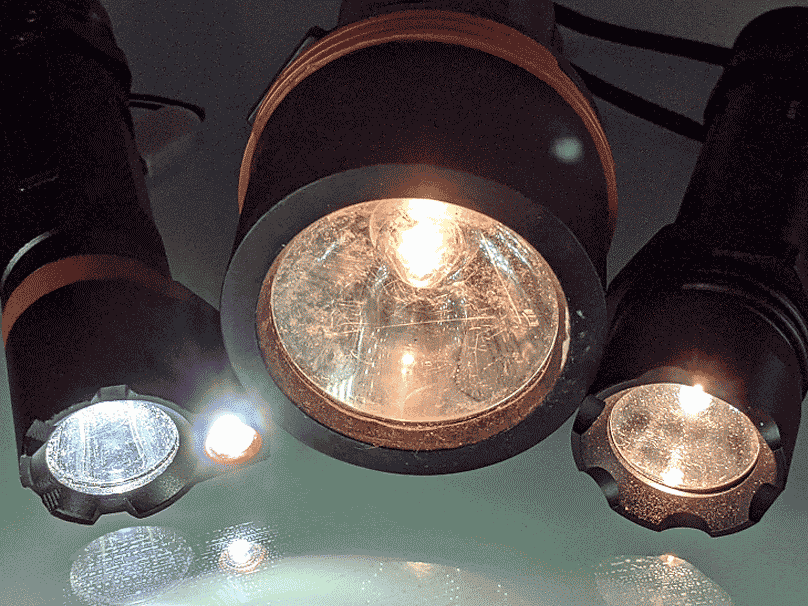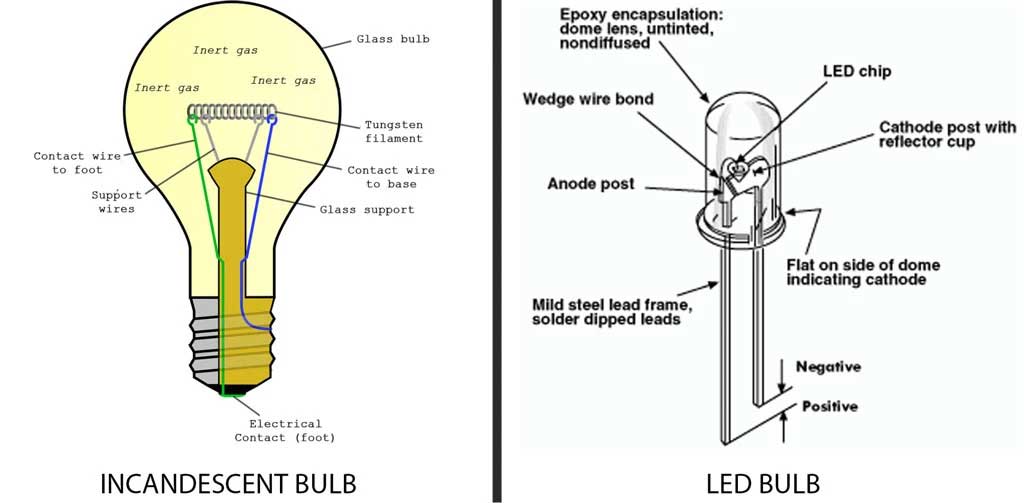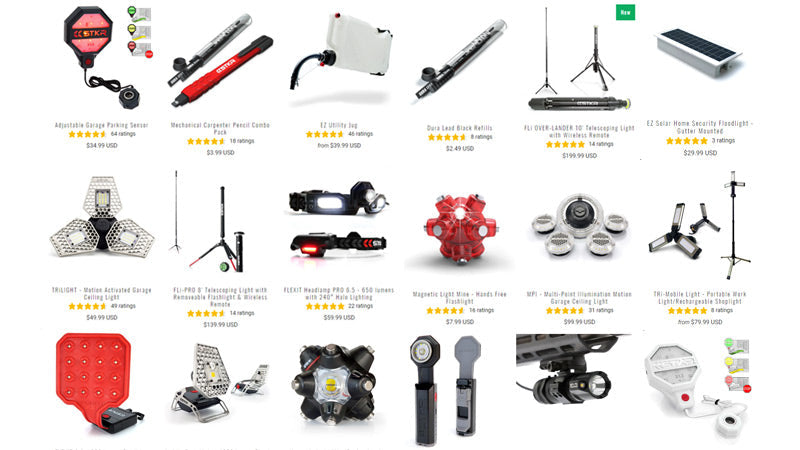
LED Versus: Incandescent, Halogen, and Xenon - The Big Bulb Guide
Share
There are so many flipp’n options of lights these days, how do you know which one to get? If you're old school like me you grew up with most of the options except for the new LED’s. So what’s the hype? The old school lights seem cheap, so why would I want to go with LED? We’ll compare LEDs to Incandescent, Halogen, and Xenon so that you can make the best buying decision for your next lighting purchase.
LED Flashlights are overall the best choice because they outlast Incandescent, Halogen, and Xenon bulbs and are more energy efficient. Incandescent bulbs last around 1,000 hours. Halogen bulbs last around 2,000 hours, Xenon bulbs around 10,000 hours, and LED’s can last up to 50,000 hours.
In this article, we will discuss the 4 different types of light bulbs and how each of them work so that you can make the best buying decision, whether it be for a flashlight or a full garage lighting system.

What is the Difference Between LEDs and Incandescent Bulbs?
An Incandescent bulb is more fragile than an LED bulb for a couple of different reasons. The outside of an incandescent bulb is made out of air-tight glass, versus an LED bulb is encased inside of a resilient epoxy.
Also, when an Incandescent light is dropped or bumped there is a good chance the fragile little metal wire or ‘filament’ within the glass can shift slightly and instantly become trash. While some LEDs can endure the drop test and still work afterwards.
This is really inconvenient in an emergency situation. The truth of the matter is that LEDs can endure a lot more vibration, shock, and all around are more durable.
Of course, this is going to vary some depending on the engineering behind the light and the durability of its material. We’ll get more into this later, but know that not all LEDs are built the same.
Which is Safer: Incandescent Bulbs or LEDs?
Incandescent light bulbs are naturally more yellow in color because the filament is composed of tungsten and it glows from heating these filaments and also produces small amounts of UV light.
This UV light could affect eye health according to Horizon Eye Specialists in their article Best and Worst Light Sources for Your Eyes. They say, “...incandescent bulbs emit the most UV radiation and cause the most damage to your eyes.” And you could apply these same concepts for your skin and the damage it could cause.
Also, incandescent lights are a higher fire risk due to their high temperature and delicate nature. Its entire light function is based on extreme heat within the glass bulb and under the wrong set of circumstances could easily lead to a fire.
The inside of a 75-watt incandescent bulb heats up to 4600° F in order for visible light to be seen. That reaction produces soot that accumulates on the inside of the glass, which also clouds and compromises the amount of light that penetrates through.
In contrast, LEDs only get up to 140°F - 212°F depending on the make and model of the LED bulb according to LIFX. That’s a huge difference in heat, meaning it’s also a huge difference in their energy consumption and waste.
Incandescent lights convert less than 5% of the energy they use into visible light, according to Wikipedia. That means out of the 4600° of heat it produces, only 5% gets converted into the light you see. That leaves 95% wasted energy which is not very efficient.
One of the biggest reasons incandescent lights are still out in the market is because they are incredibly cheap to produce and purchase, but unfortunately are not the best for the environment or your utility bill.
LEDs, on the other hand, are so much more efficient, their newer age technology makes them transform 80% of their energy into light, wasting only about 20% which is a much better ratio. These numbers are based on the research done at the Indiana University of Pennsylvania in their article, LED Lighting Benefits.
LEDs may cost a little more upfront, but in the long run it will make for less expensive utility bills. You will also save money over time not having to replace LEDs as compared to the amount of incandescent bulbs you would go through.
The natural side effect of choosing a more energy-efficient light is leaving a better carbon footprint and that’s something to feel good about.
What is the Difference Between Halogen and LED?
When comparing Halogen lights to LED lights, it might help to know that Halogen light bulbs are just a variation of Incandescent bulbs. Halogen bulbs are built with slightly better components than incandescent, but this makes them only slightly more efficient and still pose more hazard risks than most LEDs.
Halogen bulbs are composed of chemical reactions allowing halogen gas to prevent some soot accumulation and less decay to the filament consuming “nearly 30% less energy” than regular incandescent bulbs. Halogen may seem more enticing than incandescent to purchase, but let’s dive a little deeper.
Unlike Incandescent bulbs, Halogen bulbs are made out of fused quartz in order to withstand the extreme pressure produced by the chemical reactions occurring inside.
Handling these bulbs with your bare hands decreases their life span, altering their heat distribution, and increases their potential to be a fire hazard. The oils and salts left behind from your skin attract more heat to those areas creating weak spots compromising the integrity of the light bulb.
What is the Difference Between Xenon Bulbs and LEDs?
Xenon bulbs or HID (high intensity discharge) bulbs tend to be smaller than incandescent bulbs, which is ideal for a portable light, but still not as small as LEDs.
Xenon bulbs tend to have a glare to them and since they have a wider brighter light, it can be more intense if you happen to glance at them. However, because the LEDs are smaller, more LEDs can be offered in one source and in contrast are easier on the eyes.
Xenon bulbs take longer to start up because they require more energy at first compared to LEDs. The LED bulbs take the lead when it comes to their energy efficient capabilities.
Xenon bulbs are tubes that are filled with Xenon gas, and positive and negative tungsten electrodes. When electric current hits the Xenon gas it splits the atoms into small negative ions and positive electrodes currents that hit each other and jump the gaps between electrodes resulting in flashes of light.
Typically manufacturers use Tungsten because the extreme heat that is produced within the tube can be in excess of 3000°C or 5400°F. The light that is produced is more of a pure white light compared to incandescent yellow burning light, it mimics more of the bright light you would see during a lighting storm and that’s essentially what is trapped inside the xenon bulb.
Also, because of these extreme reactions and pressure inside the Xenon bulb, they are encompassed in a fused quartz envelope which can still be breakable and fragile to handle. LEDs are the only bulbs that are truly shock proof due to the light source being encompassed in epoxy, which is a more solid shatterproof material. All of the other light bulbs are more fragile, due to their glass or more breakable bulb material.

What are LEDs or Light Emitting Diodes?
Within an LED, thin layers of one way semiconductor crystalline material are made with varying amounts of electrons. Because of the imbalance, electrons naturally migrate generating a light known as electroluminescence. This process is more efficient than bulbs that burn filaments or gases to generate light, hence why they last so much longer. They essentially won’t “burn out” as fast, pun intended.
Different substrate material types are then placed within the semiconductors, these intentional imperfections provide different LEDs to display a variation of color options. This allows you to buy the exact color of LED light you prefer.
“One popular myth is that LED bulbs produce only “blue” light. However, LED bulbs are available in a range of colors and can provide warm light.” According to Horizon Light Spec. LEDs range in color from warm to cool arrays and can resemble more of what actual sunlight radiates without the harmful UV rays.
Earlier we stated that not all LEDs are made with the same quality. It’s important to go with a manufacturer that backs its lights and ensures high quality standards. These days with drop shipping products from Amajungle.com there’s no way of knowing how long any of those products will last.
Innovative companies like STKR have revolutionized the typical mobile and garage lighting to provide consumers with lights that are more versatile, offer multiple modes, dual beam functions, and flexible display of LED arrays. STKR warranties their products for a year to 3 years, upholding their customer service standards beyond the typical 30 day return policy. STKR products are designed and engineered in the US.
The Best LED Screw-in Light
For household lighting, there are new-aged lighting systems that are redefining lighting technologies year after year. Homeowners and renters can avoid rewiring their garage, basement, and attic lighting with 2 different screw-in lighting options.
The TRiLIGHT
STKR invented deformable lighting when the original TRiLIGHT came to fruition.
The TRiLIGHT simply just screws into a light bulb socket, its blades allow you to adjust and re-angle the directions of its LED panels and it provides you with 5x the amount of light you would get from a standard 60 watt bulb. And it only uses 24 watts to operate, saving you on your utility bill.
- Light Output: 4000 lumens
- Survives concrete drop test
- Optional 360° motion sensor
- Screws into existing light socket
- 3 Adjustable Aluminum Heads
- No tools needed to install, just a ladder
- Color Temperature: 5400K Daylight White
- LEDs last 50,000 hours
- SGS Certified (Tested to UL Standards)
- 3 year warranty
MPI Full System System
Speaking of custom lighting, the MPI is unlike any other lighting system on the market!
Its unique design allows you to simply screw in the main hub light and then the 4 additional LED pods can be strategically placed up to 9.5 ft way! It offers over 12x the amount of light you could expect from a standard incandescent bulb, but only needs 60 watts to run.
- 7500 True Lumens
- 5 Points of Light
- Survives drop test on concrete
- 360° Adjustable Motion Sensor up to 20’ away or light switch optional
- Quick Installation
- Built-in Cable Management System
- USB Port providing power for an External Security Camera
- Includes installation hardware for unfinished and finished ceilings
- SGS Certified (Tested to UL Standards)
- 3 year warranty
The Best Portable LED Lights:
FLEXIT Series of Flashlights:
These unique flexible flashlights are great for hands-free applications and can stick, wrap, and hang onto just about anything. Their LEDs are small and light weight and allow the user to adapt them to their lighting needs. Since they are installed in a very thin shape-loc flexible body it allows the user to transform them from spot lighting, flood lighting, to even 360° lighting just by changing the shape of the flashlight.
- 4 Options: FLEXiT Auto, FLEXiT 2.0, FLEXiT 4.0, and FLEXiT Solar
- Fully flexible body shape-Loc frame maintains moldable position
- Lineup Offers 200 - 500 Lumens
- Bend, fold, wrap, stick or hook to objects
- Spot light, a broad flood light, or a lantern with 360 degrees of light output
- Non-marring rubber magnetic durable base
- At Least 4 Modes for different lighting options
- Weather resistant
- Batteries included
- 1 year warranty
B.A.M.F. F. Series of Tactical Flashlights:
These B.A.M.F.F. Tactical Flashlights stand for "Broad Array Multi Flood Flashlight” and as their name implies are B-A and display multiple beams of light. You can use the spotlight or floodlight individually or simultaneously to create the perfect light setting. To find a flashlight that allows you to access both LEDs at the same time or separately is rare to find but essential to have.
- 6 models: the 2.0, 4.0, 4.0XL, 6.0, 8.0 and 10.0
- Lineup offers 200 - 1,000 Lumens
- Dual LED head: Spotlight and Floodlight
- Aircraft grade aluminum
- 6 modes including SOS & strobe
- Waterproof Construction
- Removable Belt Clip and Lanyard
- Multiple battery options and run times
- Beam color: white
- 1 year warranty
FLEXIT Headlamp 2.5 and 6.5 Pro
Talk about light weight, these LED Headlamps are the only way to go coming in at just under 6 ounces. Having a lightweight wearable light is vital to being able to effectively maneuver around and get your work done. They offer a main CREE LED spot light and multiple side LEDs to display a more broad halo lighting to illuminate your peripherals.
- 250 Lumens and 650 Lumens
- Low profile with weight-balanced body
- Cree LED Spotlighting for long distance
- Perihelial lighting for up close
- laminated layer of foam and soft-touch felt
- Weatherproof
- Red Hazard lighting
- 5+ modes
- Low setting to extend running time for emergency conservation
- 1 year warranty
Magnetic Light Mines
There are mini versions of these handy little magnetic lights or a large big daddy version, the light Mine Professional. Both are incredibly versatile and allow you to stick these bad boys virtually anywhere. They can be attached to metal or just set on a flat surface directing the light right where you want it.
- 360° directional lighting
- 12 neodymium Magnets
- Acts as a tripod
- Use as a pick up tool
- Weather resistant
- Run time 12 and 24 hours
- Handy for small tight spaces
- Batteries included
- A.B.S. (Thermoplastic Polymer) Body
- 1 year warranty
The Mobile Task Light:
This lightweight hands free adjustable work light is ideal to see all the details of your project and still be able to take it with you on the go. Since they are designed with LEDs, they will not get nearly as hot as those old school metal drop lights you would use when trying to make a repair.
- 1200 Lumens
- Tempered Steel Exoskeleton
- Survived Drop Testing
- Hang it, set it down, or tripod mount it
- Adjustable Aluminum Head
- Rechargeable dual lithium-ion rechargeable batteries
- 4 light modes (high, medium, low, strobe)
- Battery level indication
- 5400K color temperature (daylight white)
- 1 year warranty
Illumidome Mini Lantern
Throw it in a pool or bring it with you camping. These lanterns are made to handle the elements and create the atmosphere you’re yearning for. These lanterns allow you to transform them from a “typical” broad array lantern into a focused spot light. This really comes in handy depending on your needs like illuminating your tent versus looking for a specific fishing lure.
- 220 lumens
- Dual light arrays
- Base hanging hook
- Top hanging strap
- Waterproof
- 4 light modes including strobe
- Thick poly-carbonate lens
- A.B.S. base
- Runtime up to 100 hours on low setting
- 1 year warranty
In Summary, lights have come a long way, especially LEDs, and with technology advancing they are becoming more and more reliable, last longer, and are more energy efficient than ever before.
LEDs are the best choice because they outlast Incandescent, Halogen, and Xenon bulbs and are more energy efficient, lower heat, more durable and safer. LEDs are more money upfront but invest in them knowing Incandescent bulbs last about 42-50 days, Halogen bulbs last around 83 days, Xenon bulbs run about 416 days, and LED’s can last up to 2833 days.








